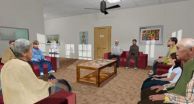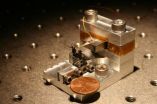The results of the two companion studies were published in the September 3, 2010 issue of the prestigious journal Science. Together, the new research sheds light on γδ (pronounced "gamma delta") T cells, an immune cell found within epithelial tissues—the thin layer of cells that makes up the outermost layer of skin and organs like the intestines and lungs.
"These cells play unique and critical roles in recognition of damage or disease in epithelial tissues," said Scripps Research Professor Wendy Havran, who headed up one of the projects. "Our study identified a new costimulatory molecule for γδ T cells that directs the wound healing abilities of these cells."
The other team, led by Scripps Research Professor Ian Wilson, focused on the underlying mechanisms of γδ T cell costimulation, which until now have remained elusive.
"Our focus was to uncover the molecular details in the cell-signaling process of γδ T cells," said Wilson. "Using x-ray crystallography, we were able to get a three-dimensional view of a costimulatory receptor-ligand pair for γδ T cells. Our two studies, together, move the basic science and understanding of γδ T cells to a new level."
Coaxing Secrets from γδ T cells Before several recent studies of γδ T cells by scientists at Scripps Research and elsewhere, little had been learned about the activation mechanisms of γδ T cells in the nearly three decades since their discovery. Scientists found that these cells arise early in fetal development in the thymus, and from there migrate to epithelial tissues.
Unlike the αβ ("alpha beta") T cells of the immune system (that are launched on a search-and-destroy mission when the skin suffers a cut or other damage), most γδ T cells do not circulate through the bloodstream. Instead, they are a major T cell component of the skin, lung, and intestine, where they take up residence and monitor the neighboring epithelial cells for damage and disease.
But do γδ T cells play other, perhaps more important biological roles in the body? This question was the focus of a Havran-led study eight years ago, which found that when skin is cut or damaged wound healing occurs faster with help from γδ T cells.
Following this study, Havran headed up two successful projects to discover exactly how the γδ T cells speed wound healing. Her team postulated—and showed—that the keratinocytes, the major type of epithelial cell in the epidermis, sense damage to the skin and then express an antigen (i.e. a molecule recognized by the immune system). This antigen is recognized by the γδ T cells, which then become activated and undergo a morphological change to become little round factories. These begin mass-producing a growth factor that binds to keratinocytes and other epithelial cells, helping them proliferate and leading to the closure of the wound. The γδ T cells also multiply to increase the wound-healing response.
Getting Down to the Basics of γδ T Cells
In the new studies, the Havran and Wilson labs combined their expertise to answer the question: Which molecules are important for the activation of γδ T cells?
Wilson came to the current study after more than 20 years of work on the structure and function of αβ T cells. In 1996, his research team was the first to solve the structure of the αβ T cell receptor.
"To become activated in your body, T cells need recognition of an antigen by the T cell receptor," Wilson explained. "And from studies on αβ T cells, we know that for most T cells, one signal is not sufficient; they need a second, or costimulatory signal. For αβ T cells, that process has been well described. What we didn't know going into this current study whether γδ T cells required a second signal or not."
These two papers do in fact identify a junctional adhesion molecule, JAML, as a new costimulatory receptor for γδ T cells that binds to the ligand CAR (coxsackie and adenovirus receptor) expressed on keratinocytes.
"When there's damage or disease, the molecules we've identified are up-regulated," said Wilson, "and signals that are transmitted through their interaction with each other costimulate a T cell response that aids in tissue repair or killing of tumors."
Deborah Witherden, a senior staff scientist in Havran lab, was first author of the study titled "The adhesion molecule JAML is a costimulatory receptor for epithelial γδ T cell activation" (also with Petra Verdino, Stephanie Rieder, Olivia Garijo, Robyn Mills, Luc Teyton, Wilson, and Havran, all of Scripps Research, and Wolfgang Fischer of the Salk Institute). Verdino, a research associate in the Wilson lab, was first author of the companion publication, "The molecular interaction of CAR and JAML recruits the central cell signal transducer PI3K" (with Witherden, Havran, and Wilson).
A Combined Effort
The Witherden et al. study showed that γδ T cells in the skin and intestine require costimulatory signals delivered to the T cells by JAML binding to CAR on damaged keratinocytes. This leads to full activation of the γδ T cells and allows them to help heal wounds.
To understand the details of how γδ T cells are costimulated, scientists needed to get a three-dimensional view of the molecular interactions that go on between CAR, the ligand on the cell surface of damaged epithelial cells and its receptor JAML on γδ T cells. To do this, the scientists turned to a technique called x-ray crystallography, which involves making crystals of ordered arrays of protein and then blasting the frozen crystals with x-ray radiation. The atoms in the protein crystals cause the x-rays to diffract, and the scientists collect and analyze the pattern of diffraction to solve the atomic-level structure of the proteins.
Through this process, the Verdino et al. study determined the exact molecular details of how CAR on keratinocytes and JAML on γδ T cells interact. Furthermore, both studies revealed how the CAR-JAML interaction induces signaling events inside the γδ T cells that ultimately lead to proliferation and effector functions needed for wound repair.
But how did this basic-science finding translate into an animal model? The Witherden et al. study found that blocking the JAML interaction with CAR in mice led to defects in γδ T cell activation and subsequent wound healing. This confirmed that costimulatory signals from JAML are essential for γδ T cell responses to wounds.
"The best part of our combined effort," said Verdino, "is that we have put together a comprehensive picture of the role of JAML and CAR for γδ T cell function from various perspectives."
The Havran lab's next study, currently under way, will investigate a role for JAML and CAR interactions in activation of γδ T cells in humans. Chronic wounds are an increasing clinical problem for patients with diabetes, major burns, and pressure sores. The current studies suggest that JAML and CAR are potential targets for future treatments to stimulate faster wound healing in these patients.
"Identification of an epithelial γδ T cell specific activation molecule gives us a unique opportunity to manipulate the T cell response solely in these tissues," Witherden said.
INFORMATION:
These projects were supported by funding from the National Institute of Allergy and Infectious Diseases and National Cancer Institute of the National Institutes of Health, the Skaggs Institute for Chemical Biology at Scripps Research, the Leukemia and Lymphoma Society, and an Erwin-Schroedinger Fellowship of the Austrian Science Fund. Facilities and equipment used in the studies were made possible by grants from the National Science Foundation and Vincent J. Coates Foundation, as well as by Stanford Synchrotron Radiation Lightsource and the Advanced Photon Source.
About The Scripps Research Institute
The Scripps Research Institute is one of the world's largest independent, non-profit biomedical research organizations, at the forefront of basic biomedical science that seeks to comprehend the most fundamental processes of life. Scripps Research is internationally recognized for its discoveries in immunology, molecular and cellular biology, chemistry, neurosciences, autoimmune, cardiovascular, and infectious diseases, and synthetic vaccine development. Established in its current configuration in 1961, it employs approximately 3,000 scientists, postdoctoral fellows, scientific and other technicians, doctoral degree graduate students, and administrative and technical support personnel. Scripps Research is headquartered in La Jolla, California. It also includes Scripps Florida, whose researchers focus on basic biomedical science, drug discovery, and technology development. Scripps Florida is located in Jupiter, Florida. See www.scripps.edu.


